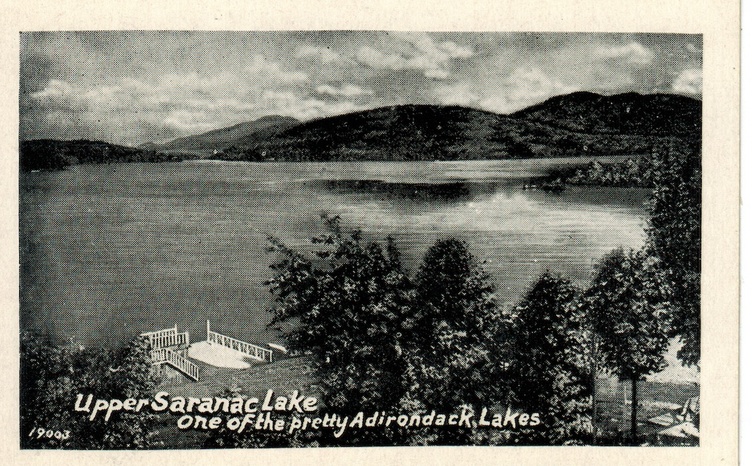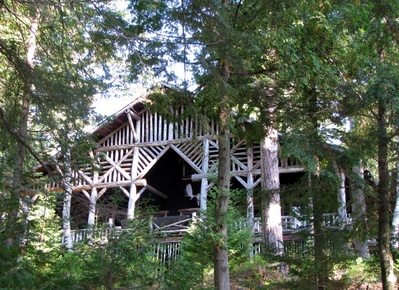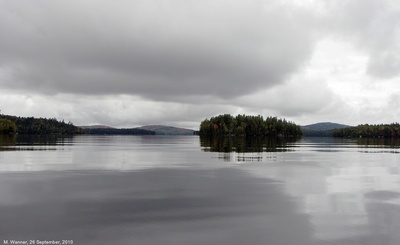 Corey Island, from the southernmost shore of Upper Saranac Lake
Corey Island, from the southernmost shore of Upper Saranac Lake 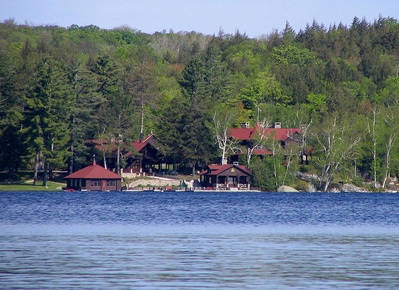 Wenonah Lodge, a great camp on the southwest shore built for Jules Bache about 1915, now subdivided, with several private owners.
Wenonah Lodge, a great camp on the southwest shore built for Jules Bache about 1915, now subdivided, with several private owners. 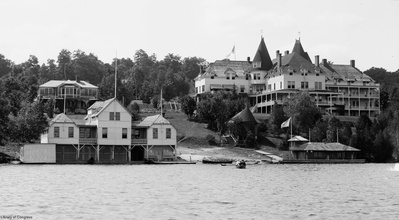 Wawbeek Lodge, c. 1909 (Detroit Publishing) Upper Saranac Lake is one of three connected lakes, part of the Saranac River, in the town of Santa Clara near the village of Saranac Lake. 1 Upper Saranac Lake is the sixth largest lake in the Adirondacks. With Middle Saranac Lake and Lower Saranac Lake, a 17-mile paddle is can be made with only one carry. There are 20 primitive campsites accessible by boat available on a first-come basis.
Wawbeek Lodge, c. 1909 (Detroit Publishing) Upper Saranac Lake is one of three connected lakes, part of the Saranac River, in the town of Santa Clara near the village of Saranac Lake. 1 Upper Saranac Lake is the sixth largest lake in the Adirondacks. With Middle Saranac Lake and Lower Saranac Lake, a 17-mile paddle is can be made with only one carry. There are 20 primitive campsites accessible by boat available on a first-come basis.
The 37 miles of shoreline is 54 percent privately owned, 2 and much of it is lined with "camps" ranging from true Great Camps to small weekend cottages. The northern part of the lake is in the town of Santa Clara, while the southern part is in Harrietstown,
History
Prior to the development of railroads and the automobile, the Saranac Lakes formed part of an important transportation route in the Adirondacks; one could travel 140 miles across, from Old Forge to Lake Champlain, almost entirely on water. The earliest settlement on the lake was built at the south end to serve sportsmen: the Rustic Lodge, built by Jesse Corey on Indian Carry, about 1850, was a simple hostelry offering room, board, and guides for hunting and fishing. Bartlett's, built soon after at the site of Bartlett Carry was similar. Bartlett's Carry enabled sportsmen to get from the Upper to the Middle Saranac Lake, while the Indian Carry crossed from Upper Saranac Lake to Stony Creek Ponds and onto the Raquette River.
In 1889, the Wawbeek Lodge (also known as the Hotel Wawbeek) was opened on the southwest shore, 1.5 miles north of the southern end of the lake, at the historic Sweeney Carry, another portage route to the Raquette. Guests could choose between luxurious hotel rooms, cottages or carpeted platform tents along the shore. Despite its scenic location and lavish appointments, it closed in 1914, a victim of high operating costs and a trend toward shorter hotel stays and increasing private camp and cottage ownership. It was demolished for salvage. In 1922, a much smaller hotel was built on the site which operated until just after the 1980 Winter Olympics. A third hotel complex was established using the buildings of the Great Camp adjacent to the hotel property; it is no longer open to the public, and the buildings, designed by William L. Coulter, have been torn down.3
The northern end of the lake was the site of the Saranac Inn, built in 1864, continued in operation until 1962; it burned in 1978. At its peak, it accommodated up to a thousand guests, and was frequented by US President Grover Cleveland and Chester A. Arthur, and New York Governor Charles Evans Hughes.
Camp Eagle Island was a Great Camp built in 1899 as a summer retreat for New York Governor and United States Vice-President Levi Morton, designed by noted architect William L. Coulter. The mainland camp, now known as Pine Ledge, was originally a part of the Morton camp. Camp Eagle Island was a Girl Scout camp from 1938 to 2008, when the Girl Scouts closed the camp and put it on the market. In 2015 it was acquired by the Friends of Camp Eagle Island. The island was included in a multiple property submission for listing on the National Register of Historic Places in 1986, was listed there in 1987, and was named a National Historic Landmark in 2004.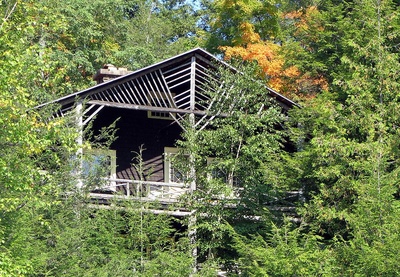 Moss Ledge
Moss Ledge 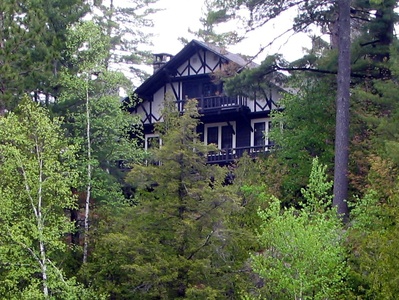 Prospect Point Camp
Prospect Point Camp
Moss Ledge and Prospect Point Camp are two other Great Camps near Saranac Inn designed by William L. Coulter. In the 1940s, the latter was sold, and had a brief career as a lodge, Sekon in the Pines. It was sold again in 1951, and used as a summer camp for young Jewish girls, Camp Navarac. In 1969, it was purchased by Young Life, a Christian non-denominational ministry based in Colorado Springs, Colorado, who use it for one-week long educational camping sessions.
The cottages that grew up around Saranac Inn (the first dozen were built by the Inn owners) still exist, as do some of the Great Camps built in the area. World War I, the Great Depression and the income tax combined to put an end to the Great Camp era, however; many were abandoned and lost for unpaid taxes, burned or left to crumble. 4
- News clippings from the late 1800s, early 1900s
- News clippings from the 1950s
- Islands, Bays, Camps
- Upper Saranac Lake Camps
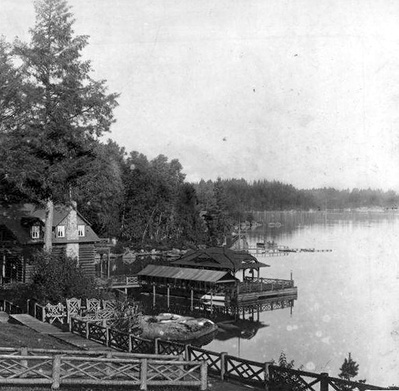 Fish Rock Camp (later Sekon Lodge), 1900
Fish Rock Camp (later Sekon Lodge), 1900
Adirondack Daily Enterprise, September 22, 1990
When Great Camps divide — more people, more pollution
Current headlines report in detail on the critical condition resulting from the blue-green algae bloom in Upper Saranac Lake. Many causes have been cited — the discharge from the fish hatchery, the blown beaver dam, improper septic systems, and the increased use of certain detergents and fertilizers.
At the turn of the century there were only 50 private camps and four hotels on the shores of Upper Saranac; today there are hundreds of camps and numerous commercial establishments.
Many of the former camp properties have been sub-divided and others have been converted to multi-occupational functions such as youth camps, religious centers, and educational symposiums. Such an increase in human usage was bound to produce an environmental impact on the body of water.
In the beginning Upper Saranac Lake sparkled clear and clean prior to any human inhabitation. Although Longfellow did not opt to have Hiawatha pitch his tepee on the shores of Gitche-Saranac, the first craft to ply the waters was most certainly the Indian bark canoe. An aboriginal summer encampment once existed at the very southern tip of the lake where the old Indian Carry from Raquette River terminated. The native birch canoe floated on the water, "like a yellow leaf in autumn, like a yellow water lily," and trailed no pollution. Unfortunately the white man has not been so tidy.
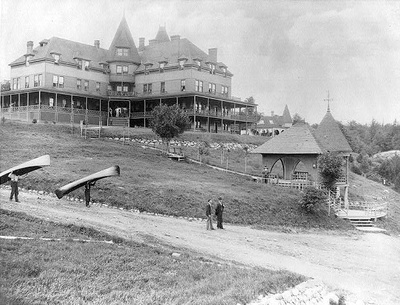 Hotel Wawbeek, 1890 (Seneca Ray Stoddard)
Hotel Wawbeek, 1890 (Seneca Ray Stoddard)
Of the three lakes making up the popular Saranac waterway chain, Upper Saranac is predominant in most categories. It s the largest of the three and forms the headwaters of the lake and river system. It also ranks well ahead of the Middle and Lower Lakes in richness of local History. Eight miles long it varies in width from two miles at the Northern sector to less than a quarter mile at the mid-section narrows. Geographically its eight-mile length runs in a true north-south alignment with a mean elevation of 1573 feet.
Historically the lake, as with most of northern New York State, lay entirely within the bounds of Albany County. Later the colonial governor, William Tryon, divided the huge county into two counties naming Tryon for himself and Charlotte for King George's daughter. With Tryon on the west and Charlotte to the east the north-south survey line dividing the two counties ran the full length of Upper Saranac.
At the close of the Revolutionary War the victorious patriots renamed the counties to honor American heroes. Tryon became Montgomery and Charlotte became Washington. Today the lake lies entirely within Franklin County, the northern three-quarters being in the Town of Santa Clara, and the southern quarter in the Town of Harrietstown.
Perhaps the first white settler to arrive on Upper Saranac was Jesse Corey who came to the west shore in 1830. Corey made an exploratory trip to the wild west but returned in 1850 to build his Rustic Lodge on the site of the aforementioned Indian colony at the southern tip of the lake. His previous site on the west shore was taken over by John Sweeney who built a log lodge to accommodate an influx of sportsmen and their guides who were making their way across a three-mile carry between Upper Saranac and the Raquette River to head downstream to Tupper Lake. Quite naturally this portage became well-known as the Sweeney Carry.
Since no roads existed in the area in 1857 the guide boat served as the main means of transportation along the numerous waterways. An established carry between any two bodies of water became the ideal location to establish a tourist lodge and Corey, Sweeney, and Virge Bartlett each took advantage of such a site related to Upper Saranac. At the Raquette end of the Sweeney Carry a small house was maintained by Oliver Tromblee and a horse-drawn wagon carried boats and luggage between the two points. Much later, in 1891, the Sweeney lodge was replaced by the elegant new Wawbeek Hotel.
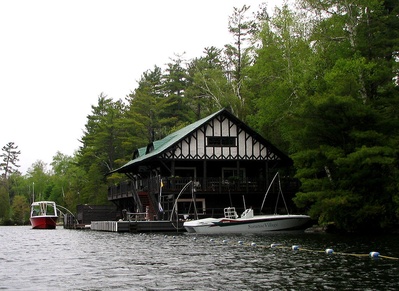 Prospect Point Camp boathouse
Prospect Point Camp boathouse
In 1854 Virge Bartlett had built his carry lodge on the opposite side of the lake on the headwaters of the Saranac River. One of the most popular of all Adirondack carrying places, it is still known as Bartlett's Carry and has served the boating public over a span of 136 years of usage. At the extreme northern end of the lake, in 1864, Hough's lodge became another Upper Saranac site destined to share a very prominent role in the lake's history. Ed Derby took over the hotel and operated it until 1886 under the name of the Prospect House.
It next became the famous Saranac Inn and was greatly expanded by the Upper Saranac Association under the group's president, Dr. Sam Ward, and after some 90 years of operation it had outlived all of the other area's hotels.
Prior to, and during the evolvement of these Upper Saranac lodges, the lake was visited by a diverse roster of hunters, fishermen, authors, artists, and many prominent figures of varying degrees of fame who had discovered the lake to be a camper's delight. In 1854 S. H. Hammond published an account of camping experiences called Hunting Adventures in the Northern Wilds in which chapter XIII is devoted to Upper Saranac where he dwelt in a "shantee of poles" erected by his guide.
During the following year, in September of 1855, an English lady of note arrived at the lake when the Hon. Amelia M. Murray, Queen Victoria's maid of honor, came during her tour of the Adirondacks accompanied by Governor Horatio Seymour. Her personal guide and oarsman was that famous old teller of tall tales, "Uncle Mart" Moody of Tupper Lake and there is little doubt but that he regaled his royal client with some of his outrageous humor. While camping on the lake shore the guest of honor was awakened during the night by what she thought to be the howl of a wolf but after being assured by Moody that it was only a screech owl, she resumed her sleep. After a breakfast of pork, trout, and potatoes, Lady Amelia went to an empty guideboat on the shore to wash and brush her teeth in Upper Saranac's crystal waters.
In 1860 state Librarian, Alfred B. Street, produced his Woods and Waters in which he mentions an Indian settlement that once existed at the south end of the lake as mentioned earlier in this writing. Among the many other celebrities to pass through Upper Saranac and wend their way over the Indian Carry was, without a doubt, the most famous group of intellectuals to have ever camped out in the Adirondacks. A gathering of Bostonians, which became known as the Philosophers' Camp, crossed the lake in a fleet of guideboats from Bartlett's to Corey's enroute to the Raquette River and "Follensbee" Pond where they camped during August of 1858.
Led by William J. Stillman the group contained such notables as Ralph Waldo Emerson, Louis Agassiz, James Russell Lowell, John Holmes, and Judge Ebenezer Rockwell Hoar who later became President Grant's Attorney General. Emerson penned a poem entitled "The Adiron-dacs" to commemorate the vacation, which in part read:
"By the bright morn the gay flotilla slid
Through files of flags that gleamed like bayonets,
Through gold-moth-haunted beds of pickerel-flower,
Through scented banks of lilies white and gold,
On through the Upper Saranac and up Pere Raquette stream."
No mention of a blue-green algae bloom!
With the turn of the century came a new breed of campers to Upper Saranac together with a more permanent occupation plan. No rough "pole shantees" were on the agenda this time around but rather palatial summer homes heralding the arrival of the early 1900 millionaires. During the following decade there appeared such prominent names as Jules Bache, Adolph Lewisohn, Isaac Seligman, Cleveland Dodge, Sidney Colgate, John Agar, Otto Kahn, Howard Bucknell, C.W. Chandler, Thomas Blagden, and the Swenson Brothers. Among the "great camps" which dotted the shorelines were both descriptive and Indian names like: Fish Rock, Sekon, Wenonah, Beechwood, Bungalow Bay, Bull Point, Gull Point, Pine Point, Santanoni, Blythmere, Pine Brook, Moss Ledge, and Panther Point. All alone on Eagle Island was Vice President Levi P. Morton's camp.
The stock market crash and the ensuing depression forced the closing of many of these elaborate camps as Upper Saranac Lake suffered its first economical decline. Some of the larger estates remained in idle limbo and various stages of both neglect and disrepair until after World War II when a post war boom brought a resurgence of investments in lakeshore properties. The 1950s and 60s witnessed a binge of real estate transactions involving the purchase and subdivision of the larger Upper Saranac holdings. There was a ready and willing market eagerly awaiting the sale of these smaller parcels and a new prosperity enabled the middle class to own "a place in the sun," a privilege once enjoyed only by the very wealthy.
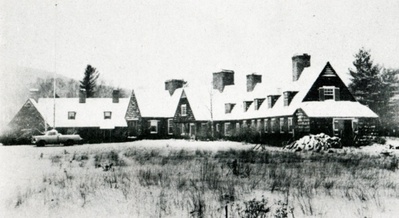 Swenson Camp at the southern end of the lake (Adirondack Daily Enterprise, September 22, 1990)
Swenson Camp at the southern end of the lake (Adirondack Daily Enterprise, September 22, 1990)
The largest subdivision in the lake's history took place in 1962 when the vast Saranac Inn property fell under Charles Vosburgh's auctioneering gavel. Other major camps that have been sliced up include Stanley's Blythmere, Earle's Moose Point, and Seligman's Fish Rock to mention but a few. However, when the few are divided into hundreds it becomes obvious that the phosphorus-nutrients entering the lake have increased in proportion to the multiple shoreline dwellers. Can we have it both ways?
In direct contrast to population growth the fishing in Upper Saranac has suffered an unpopular decline. When the Hammond, Street , and Murray parties reached the lake, its depths could provide limitless trout. Of late, the speckled trout, land locked salmon, and whitefish have all but disappeared. Some lake trout have managed to survive but none taken recently can compare with George Doty's catch of 1936. His huge lake trout tipped the scales at 31 1/2 pounds.
According to Mitchell Sabattis the Indian name for Upper Saranac was Sin-ha-lo-nen-ne-pus, which translates to "large and beautiful lake." Some of the early guide books claimed that the Indians called the lake "Lake of the Silver Sky." Unfortunately the current nomenclature applicable to Upper Saranac Lake seems to be "the Waters of the Blue-Green Algae Bloom." If the Lady Amelia Murray could once more return to its shores, she would undoubtedly refuse to brush her teeth in Upper Saranac's waters.
Tupper Lake Free Press and Herald, May 11, 1967
Passing Years Brought Major Changes To Camp Colony on Upper Saranac Lake
Upper Saranac Lake, "end of the line" in the chain of water ways followed by the earliest visitors to this region more than a century ago, and the jumping off point for Tupper and Long Lake country via the Indian Carry and the Raquette River, saw its first rough, camps slapped together back before the Civil War.
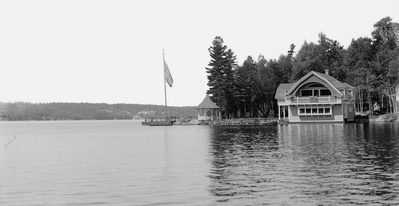 Douglass Point (Detroit Publishing Co., c. 1900-1910) Along toward the end of the 19th century a number of very wealthy men, some of them internationally known, became interested in the area, and the era of rough hunting and fishing camps was over.
Douglass Point (Detroit Publishing Co., c. 1900-1910) Along toward the end of the 19th century a number of very wealthy men, some of them internationally known, became interested in the area, and the era of rough hunting and fishing camps was over.
Starting around 1890, some of the most palatial camps in the northern Adirondacks were erected there… Upper Saranac, from the late 1890s until recently, was probably the most exclusive camp colony of the region, and for years many Tupper area residents found Employment there as caretakers or camp crew, in maintenance work, while local business found the Upper Saranac camp trade a lucrative extra source of income.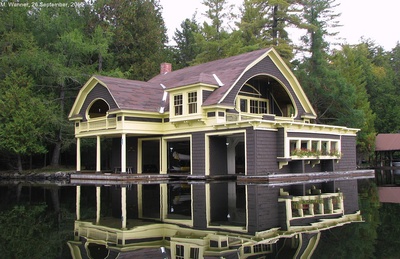 Douglass Point boat house
Douglass Point boat house
The years have brought changes . . . With the passing of the generation which built the camps, came a slackening of interest, and gradually most of the larger properties have been sold off, broken up, and in some instances, given away to educational or church institutions, Boy Scout and Girl Scout Councils… Some once-exclusive summer estates have been reduced to commercial ventures.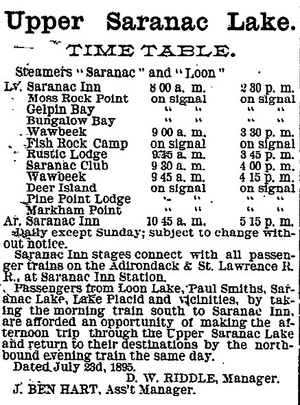 Essex County Republican., August 29, 1895
Essex County Republican., August 29, 1895
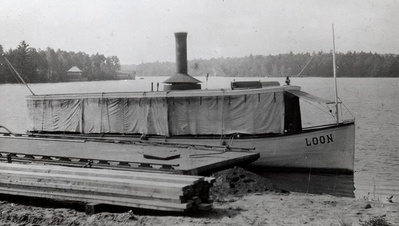 The Freight Steamer Loon, c. 1890
The Freight Steamer Loon, c. 1890
Courtesy of the Adirondack ExperienceSome went under the auctioneer's hammer and were fragmented into scores of small parcels.
We are indebted to Fred Derby for some notes on the changes which recent years have brought there... Probably no one is more familiar with the story than Mr. Derby, who was born on Upper Saranac Lake in 1895, at which time his father was caretaker at the Bucknell camp, and who has lived and worked around the lake most of his life... As he pointed out in compiling some notes for us, memories fade with years, and there may be some omissions or errors in this tally . . . If so, we'd appreciate having them brought to our attention, "Just for the record"...
Mr. Derby recalls when Rustic Lodge, on the site later occupied by the Swenson camp, was operated by Charlie Wardner, and the old Wawbeek Hotel, a famed tourist resort in its day, was run by J. Ben Hart... The Bartlett Carry Club had been formed by R. D. Douglass of Orange, N. J., and two of his brothers, and was operating on the carry along the stream linking Middle and Upper Saranac Lake, where Virgil Bartlett began catering to the pioneer "sports" away back in 1855... Saranac Inn, where the first crude little hostelry was erected prior to the Civil War, was a busy summer resort, internationally known, and was served by rail, with its own station, and two steamboats, the Loon, a freight boat, and the Saranac, a mail and passenger boat, plied the lake.
Camp Wenonah, long one of the lake's showpieces, the property of Jules S. Bache, whose brokerage offices operate across the country, is now operated as a tourist resort by G. Palanzo and A. Maffia, New York city...
Fish Rock Camp, which comprised a score of rustic log buildings, built by Isaac Seligman and a landmark on Upper Saranac since the turn of the century, has been subdivided into more than fifty parcels, with the main camp operated as Sekon Lodge...
The former Walters Camp, owned by Henry Walters, is now the Camp DeBaun boys' school, operated by Mr. and Mrs. Howard Edwards of Oceanside, L. I.
Bull Point, another landmark, built in the late 1800s by Otto Kahn, internationally known banker and owned for many years by Henry Goldman, is now a motel development owned and operated by Guy Lake...
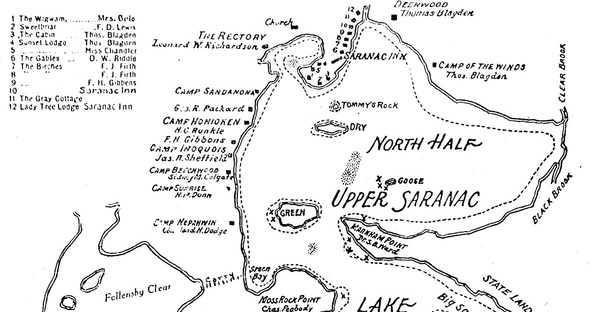 Prospect Point, the former Adolph Lewisohn property, is now Camp Navarac, a girls' school.
Prospect Point, the former Adolph Lewisohn property, is now Camp Navarac, a girls' school.
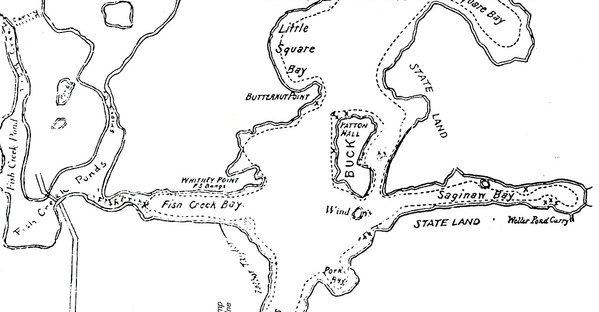 Gilpin Bay formerly the property of Herman Rosenbaum, is now owned by Syracuse University and operated as a summer art center.
Gilpin Bay formerly the property of Herman Rosenbaum, is now owned by Syracuse University and operated as a summer art center.
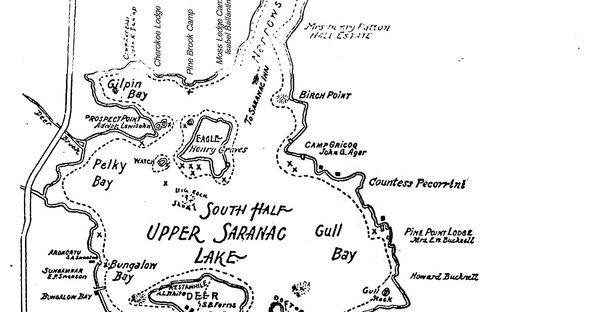 Moss Ledge Camp, formerly owned by the Ballentines of the family which owns the Ballentine breweries, is also now the property of Syracuse University.
Moss Ledge Camp, formerly owned by the Ballentines of the family which owns the Ballentine breweries, is also now the property of Syracuse University.
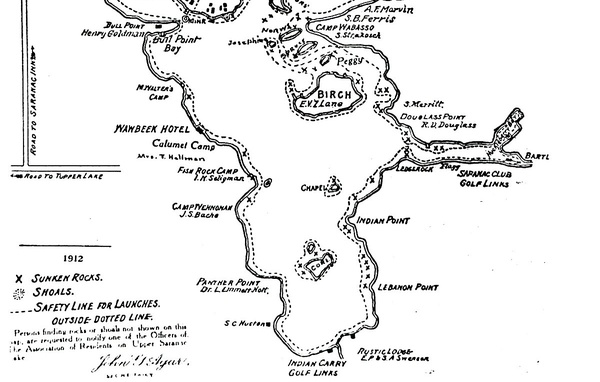 1912 Upper Saranac Lake map, courtesy of Natalie LeducCamp Grigog [sic] the large and attractive colonial-type place across from Eagle Island, on the east shore, formerly the property of John G. Agar, has been subdivided by Emerson D. Wertz, Miami. Fla. real estate man, who has also subdivided Blythmere Camp, formerly the property of R. D. Douglass, who was with Dun and Bradstreet of financial rating fame . . .
1912 Upper Saranac Lake map, courtesy of Natalie LeducCamp Grigog [sic] the large and attractive colonial-type place across from Eagle Island, on the east shore, formerly the property of John G. Agar, has been subdivided by Emerson D. Wertz, Miami. Fla. real estate man, who has also subdivided Blythmere Camp, formerly the property of R. D. Douglass, who was with Dun and Bradstreet of financial rating fame . . .
Pine Point is now the property of a Rochester surgeon. Dr. Thompson. The camp was orginally the property of Mrs. Emma Bucknell, whose family founded Bucknell College at Lewisburg, Pa., and was later owned by Col. S. P. Wetherell of Philadelphia.
Eagle Island, once owned by Gov. Levi P. Morton, and for many years the property of Henry Graves, is now owned by the Girl Scouts of Orange. N. J.
Deerwood, just beyond Saranac Inn, where the sight of deer roaming through the fenced park acreage used to stop traffic, and which was the site of Deerwood Music Camp for several years, has been razed.
The Patterson and Earl camp properties are now owned by George Donaldson, who operates a popular campers' supply shop and development at Fish Creek...
Land's End, the former Ross Camp, was given to the Presbyterian Church, and is now the setting for the Land's End Conference Center, owned and operated by the Presbyterian Synod of New York. Panther Point, another well known showpiece for many years, has been broken down into smaller parcels, owned by Major Day, Fred Derby, Mrs. William E. Perry of this village, and Larry Holder of Binghamton . . .
The Swenson property is now owned by G. Nowakoski and B. G. Nemeroff, New York city.
The men who converted Upper Saranac into an exclusive and tightly held colony of the great and wealthy sixty or seventy years ago would probably be shaken by some of the changes the years have brought, if they could come back to look it over today... But it still remains one of the most beautiful bodies of water in the Adirondacks, —the same old "shop" operating under new management . . .
Plattsburgh Press Republican, September 5, 1993
Great Camps
Adirondack history is preserved in three Coulter-designed camps
By JEFF MEYERS
SARANAC LAKE — Many of the Great Camps of the Adirondacks are similar in setting, history and architecture, but there are also some striking differences in how the camps have survived the passage of time.
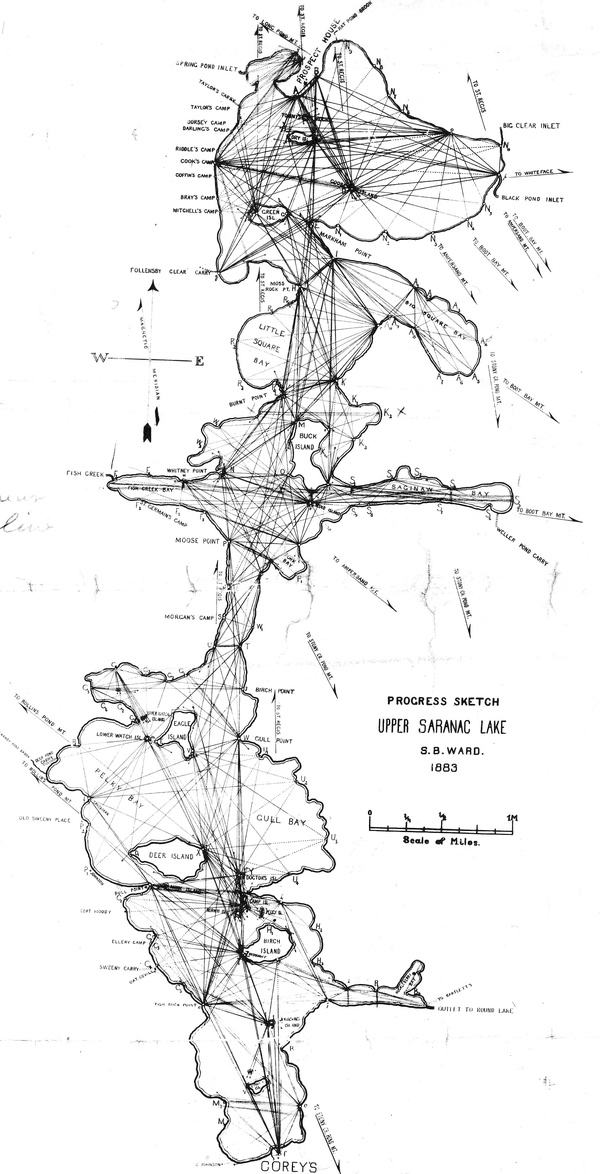 1883 map of Upper Saranac Lake including points of triangulation, coastal features, carries, islands, camps, points of direction to specific mountains, and hand written notations. Scale [1:31680]. Original map size 24 x 13 inches. Original map is held by the Dept. of Environmental Conservation.
1883 map of Upper Saranac Lake including points of triangulation, coastal features, carries, islands, camps, points of direction to specific mountains, and hand written notations. Scale [1:31680]. Original map size 24 x 13 inches. Original map is held by the Dept. of Environmental Conservation.
New York State ArchivesThree Great Camps, located on Upper Saranac Lake, were the target of a recent tour hosted by the Adirondack Architectural Heritage. About 50 people attended the day-long tour, traveling by boat to Eagle Island and then by foot-to Moss Ledge and Prospect Point, summer retreats for the wealthy nearly a century ago.
The three rustic camps designed by William L. Coulter, represent a perfect example of how historic preservation can work.
Eagle Island, a 33-acre, thickly wooded parcel now owned by the Girl Scouts, was once the summer resort of Levi P. Morton, the 31st governor of New York and vice-president of the United States under Benjamin Harrison.
Coulter built the main lodge and several other buildings in 1903 using a rustic timber design combined with a more traditional shingle effect. The camp also featured numerous screened windows: popular tuberculosis treatments of the time called for plenty of fresh air.
Today, the camp appears very much the way it did when Morton spent his summers there.
The Girl Scouts have transformed one of the buildings into an infirmary, and they have expanded the dining hall, but the camp still holds that "Great Camp" atmosphere that makes it historically valuable.
"They've done a wonderful job here," said Mary Hotaling, who hosted the tour for the Architectural Heritage. "They have made a real effort to keep the buildings looking like they did nearly 100 years ago."
In fact, the Girl Scouts don't use the buildings that often. Most of their time is spent at the opposite end of the island where they pitch their tents.
Moss Ledge is located on the mainland, directly opposite Eagle Island. Coulter built the series of rustic cabins in 1898 for Isabel A. Ballantine.
"This camp was built to be seen from the lake," said Patricia Pollock, who has owned the camp with her husband, Herbert, since 1972. "The house was built before any roads were here, and the only access was by lake. There is a distinct front (facing the lake) and back to the buildings."
Coulter positioned his camps on a point. The three buildings remaining, though next to one another, are not in a row but squarely face the lake. "They're not exactly in a line; they don't look like three suburban houses," Patricia Pollock said.
The main lodge, sitting between a guest house and Ballantine's dining room, is emphasized with log plankings. A large main-floor porch and a secondary porch on the upper level highlight the structure.
Ballantine gave the camp to the Girl Scouts in 1945. In 1949, Carl Loeb purchased Moss Ledge and donated it to Syracuse University, which already owned neighboring land. Syracuse used the camp for housing and as an adult art camp. Much of the furniture still on site was owned by the University.
Prospect Point, less than a mile south of Moss Ledge, was built in 1903 by Coulter and his new partner, Max Westhoff, for Adolph Lewisohn.
Lewisohn was a son of a German merchant family who emigrated to the United States in 1867 and developed a successful copper-mining business. Today, copper fixtures still highlight much of the camp, which was the largest and most elaborate of Coulter's Adirondack camps. Young Life-Saranac Village, non-denominational Christian camp that caters to more than 250 kids per week, now owns the camp. Robbie Robertson directed the tour, leading the visitors through a maze of camp-like structures.
Unlike Eagle Island and Moss Ledge, much of the original design has been renovated and expanded.
The lakeside exteriors, however, retain their Great Camp style, and any new buildings Young Life erects are designed in a similar rustic fashion, Robertson said.
ON MOUNTAINS AND LAKES
The Saranac Region.
Saranac inn, at the head of Upper Saranac Lake, will be conducted this season on the same methods as of yore. For a generation this inn has been one of the favorite resorts of sojourners in the Adirondacks. It remains under the management of D. W. Riddle, with J. Ben Hart as assistant. Old patrons of this place will be interested in learning that the operation of the township reclamation land law will deprive Saranac Inn of a very large slice of its landed estate. The inn is reached by a two-mile stage ride from Saranac Inn Station, and from the convenient steamboat landing near the inn the tourist may board a small steamer and go to the foot of the lake, where are situated the Hotel Wawbeek, Rustic Lodge, Saranac Club, and the Hiawatha House. The Wawbeek, which is one of the largest and best-known hotels in this region, will continue under the management of Uriah Welch, the same as last year. Some minor; improvements, were made about the premises this Spring...
…Isaac N. Seligman's Fish Rock Camp is on Upper Saranac Lake, and E. P. Swenson's Bungalow Bay is there also. Other persons who have camps in that neighborhood are Mrs. E. W. Bucknell, Dr. S. B. Ward, Charles Peabody, W. H. Jackson, Dr. C. A. Herter, Rudolph Kissell, Cleveland Dodge, Pliny Fisk and H. G. Runkle, J. S. Bache, Dr. W. P. Howell, J. G. Agar, Mrs. C. W. Chandler, Mrs. George Seligman, Dr. L. E. Holt, Thomas Blagden, Frank J. Firth, F. S. Bangs, Howard Bucknell, S. Strakosch, A. L. White, and Edwin and S. B. Ferris…
Brooklyn Daily Eagle, July 8, 1900
ADIRONDACKS
SARANAC LAKE, July 7—At no time since the Adirondacks began to be visited by health and pleasure seekers have the prospects of a brilliant and successful season been so bright as now.
NOTES.
Colonel Belo, who has a cottage on the upper Saranac, the Lone Star, which he has occupied every season for a number of years, is back for the summer. Francis S. Bangs of New York, and his family, is ensconced in their handsome cottage, Kinderwold, while the R. W. Johnsons are again at the Barney cottage.
Many campers came in unusually early. They know that they cannot live always, and they "care to stay" as long as they can each summer at their dolce far niente cots along the Saranac's shady shores. The E. P. Swensons, New York, are at the Bungalow; the S. B. Ferrises of Lakewood, N. J.. are at Birch Isle. and the S. Strakosches, also of New York have been settled at Camp Wawbasso for weeks. Mrs. E. W. Bucknell of Philadelphia has reopened her Pine Point Lodge and Miss I. A. Ballantine of Newark is to take possession of Moss Ledge Camp. O. H. Kahn of Morristown is building one of the moat magnificent camp's on the lake and Mr. Walters is building a new boat house at Bull Point.
Dr. Herter's camp, on Birch Isle, has been rented for the season to Mr. Hoffman Miller of New York, who took possession the latter part of June. The camp on Deer Island occupied last season by Bayard Cutting has been rented this season by Mrs. Calvin S. Brice, widow of the late Senator Brice. The Levi P. Morton camp has been rented to Congressman Sprague of Massachusetts. Mr. and Mrs. Theodore Marburg and family of Baltimore are occupying Fairview, and Dr. and Mrs. Munn and family are at Hillside. The steamer Saranac began her regular trips around the lake on July 1. The golf links have been put in excellent condition. One of the new attractions which will be appreciated by wheelmen is the new road recently built between Wawbeek and the Saranac Inn.
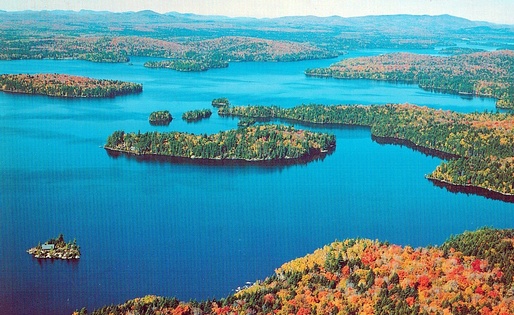 Chapel Island, lower left; Birch Island, center; Deer Island, upper left; Postcard courtesy of Noreen OslanderNew York Times, August 24, 1902
Chapel Island, lower left; Birch Island, center; Deer Island, upper left; Postcard courtesy of Noreen OslanderNew York Times, August 24, 1902
Wawbeek
Many Well-Known People in Their Camps.
Special to The New York Times
"WAWBEEK, N. Y., Aug. 23.—Hoffman Miller and the members of his family have Dr. Herter's camp Birch Island this Summer, and Foxhall Keene has taken possesion of Howard Bucknell's camp across the lake from the Wawbeek. Mr. Bucknell is spending the remainder of the Summer at the camp of his mother, Pine Point Lodge.
Deer Island, the location of the Adirondack home of S. B. Ferris of New York, and where the wedding of Miss Ferris is to be celebrated next month, is also the home this Summer of Mr. and Mrs. H. C. Shaw and the members of their family, who have one of the Deer Island cabins.
John G. Agar, the New York lawyer, has arrived with the members of his family at the Agar cottage, which is one of the finest in the region.
Mr. and Mrs. J. W. Richards, the Misses Richards, Austin Colgate, George Agness, Miss M. L. Parmlee, and Mr. and Mrs. Sidney M. Colgate of New York, who are at Camp Beechwood, the Adirondack home of Mr. and Mrs. S. M. Colgate, are frequent visitors at Hotel Wawbeek.
The annual Upper Saranac Lake fair for the benefit of the Adirondack Cottage Sanitarium is being held at the Hotel Wawbeek today. The details at Hotel Wawbeek and at Saranac Inn are in charge of Mrs. J. Ben Hart and Mrs. Riddell respectively.
Late arrivals at the Hotel Wawbeek include the following: Mr. and Mrs. B. A. Taggart, Miss Edith M. Taggart, Miss Ruth S. Taggart, Mr. and Mrs. Charles A. Anderson, J. P. Munn, Mr. and Mrs. M. Harrington, Miss M. Helen Harrington, Arthur Melvin Harrington, Mr. and Mrs. B. H. Bail, Mrs. C. M. Kerr, Miss Sophia M. Brady, Miss Emma Brady, Hamilton Brady, Miss Dana, Miss M. Dana and maid, E. Tierney, W. D. Harrison, George I. Hartt, Miss Mae Roe, Dr. S. C. Hart, Mrs. Maben, Miss Maben, Dr. and Mrs. Edward Brooks, Mr. and Mrs. C. W. Smith, Dr. and Mrs. Charles T. Kerley, J. C. Howard, F. W. Howard. Mr. and Mrs. Joseph Thall, Mr and Mrs. E. Mason, Dr. and Mrs. Stuart, W. Moore, Mrs. Lucy P. Eastman, Eastman Bell, Henry Bell, Jr., Lucy P. Bell and maid, and Mr. and Mrs. E. W. Kimball, New York.
C. D. Findley of New York has arrived at Saranac Inn, where his father, William L. Findley; his sister, Miss Findley, and his brother, William V. B. Findley, all of New York, are spending the Summer.
Mrs. F. W. H. Sheffield of Utica has been visiting Mrs. Tod of New York, who has the new Gibbens cottage at Saranac Inn this Summer.
Mr. and Mrs. George E. Burroughs Torrey, Frederick J. Winston, Thatcher M. Adams, and D. T. Leahy, all of New York, have been among the recent visitors at Saranac Inn.
Among the late arrivals at Saranac Inn are the following: Mr. and Mrs. T. W. T. Maxwell, Mr. and Mrs. C. N. Smith, Guilbert H. Turner, Guilbert C. Dodge, Miss Florence Hall, Mr. and Mrs. Hiram A. Bliss, M. L. Eaton. Mr. and Mrs. J. H. Coon, Jr., Miss Alice W. Smith, Miss Anna Hampton Barnes, Mr. and Mrs. C. H. Barber, Miss Helen Hull, Mr. and Mrs. R. P. Worrall, Miss A. Gatchel, Mr. and Mrs. Walter B. Smith, Alan G. Smith, M. W. Lawrence, and Miss J. L. Jones, New York.
Mrs. J. A. Crawford, Miss M. M. Crawford, Miss C. E. Crawford, Mrs. T. M. Sweeney, Mrs. L. M. Crawford, and James A. Crawford were at Saranac Inn recently en route to Hiawatha Lodge, where they are to remain some time.
Plattsburgh Republican, March 28, 1903
New Adirondack Camps.
A number of elaborate camps are being built in the Adirondacks, and extensive improvements and additions are being made to others…
Camps are also being built for Hon. Levi P. Morton on Eagle Island, in the Upper Saranac Lake, by Trombley & Corried [sic, Carrier] of Saranac Lake, to cost about $25,000.
R. D. Douglass of New York is having a new camp, boat house, power house and steamer dock built on the Upper Saranac The boat house will probably be the finest on the lake, the lower part containing launch slips and boat racks, with the second story a billiard room.
Adolph Lewisohn of New York is also building a large camp, with boat house, guide house, etc., on Prospect Point, Upper Saranac, to cost nearly $75,000.
A large cottage is being added to the Kahn camp, on the Upper Saranac. S. B. Ferris is also adding a cottage to his camp on this lake. These, with the extensive improvements being make by the Upper Saranac Lake Association to the Saranac Inn property will make the upper lake one of the most popular in the mountains…
Malone Farmer, June 17, 1903
ADIRONDACK CAMPS
Some New Ones--Some Greatly Improved.
A Paul Smith's dispatch of recent date says:
"…A new camp has been built in South Bay, Upper Saranac Lake, for Thomas Sturgis of New York, the fire commissioner. Mr. Sturgis has been stopping at the Inn for some time this spring.
"Among the several new buildings in construction along Upper Saranac Lake is a camp for Levi P. Morton on his Eagle Island property. Last fall Mr. Morton sold his camp, Pine Brook, near the Wawbeek, to Mitchell A. Cass Levy, of New York, and Mr. Levy has leased it to Mr. and Mrs. Percy R. Pyne. There are seven buildings in the new Morton camp, which consists of a family lodge, dining room, Mrs. Morton's lodge, guests' cabin, laundry, guide house, &c. Shingles are used on all the exteriors. A feature of the interior of the dining room, which is finished in peeled spruce, is what is called an umbrella in the ceiling. Timbers center here from each of the eight angles of the room, the center post being fourteen inches in diameter and supported by trusses in the roof...
New York Times, July 7, 1907
SARANAC CLUB BUILDING
Much Interest in Motor Boats In the Wawbeek Region.
Special to The New York Times,
WAWBEEK, N. Y., July 6.—Wawbeek Lodge is enjoying a very prosperous season, improvements in camps, highways, and in the launching of new and speedy water craft are among the features of the season. Noticeable among the changes is the plan of S. A. and E. P. Swenson to build a new highway [Panther Mountain Road?] along the southern end of the lake. This highway will be built at an expense of about $15,000.
There has been considerable new building at the Saranac Club, including the construction of a new electric light plant and a new boathouse. Benjamin Douglas has launched his new Alaho [Aloha?], one of the fastest automobile boats that plies the waters of any Adirondack lake. Mr. Douglas is also the owner of the Llewellyn, the electric yacht, which made the journey from Palm Beach to Plattsburg under its own power, and which is now launched here.
D. P. Kingsford of New York has built a new camp on Caper Point, Middle Saranac Lake, which is now ready for occupancy.
The magnificent camp of Mr. and Mrs. Levi P. Morton, Eagle Island, has been leased for the Summer by Mr. and Mrs. E. J. King, Jr., of New York.
Mr. and Mrs. Siegfried Strakosch of New York will occupy apartments at The Wawbeek this season. Mr. and Mrs. Joseph Eastman and the members of their family will spend the Summer at The Wawbeek.
Dr. and Mrs. L. Emmett Holt of New York will occupy their Panther Point camp. Camp Restawhile has been made ready for the coming of Mr. and Mrs. A. L. White. Dr. A. L. Wood will spend the Summer at his Corey Island camp. Mr. and Mrs. Robert Dunn Douglass of New York are expected to arrive within a few days at Camp Blythmere. John G. Agar will open Camp Gricoq. Mrs. E. W. Bucknell has been spending several days at her camp, Pine Point, and Mr. and Mrs. W.H. Jackson and the members of their family will be among the early July arrivals at their camp, Cherokee Lodge.
New York Times, July 12, 1908
MOTORING IN MOUNTAINS.
Adirondack Campers Realize How Autos Enhance Summer Pleasures.
Special to The New York Times.
WAWBEEK, N. Y., July 11.—Adirondack campers are awakening to the pleasures of motoring in the mountains, and in the majority of Instances are beginning to find their touring earn an indispensable feature of camp life. Considerable time and money are being expended in the improvement of highways in the vicinity of the Upper Saranac Lake, and motoring promises to be the coming sport of this National playground. The new road upon which E. P. Swenson has been engaged is now completed and adds much to the comfort of those who journey through this section.
John G. Agar, who has a home on the Upper Saranac Lake, is having a garage built at the Wawbeek for the housing of his cars. Mr. J. B. Dickson of the Pennsylvania Railroad, who is occupying Eagle Island, the Adirondack place of Levi P. Morton, will also bring his touring car to camp. The car will be housed at Wawbeek, which is the motoring headquarters this season.
Mr. and Mrs. Henry A. Vanhiew of New York and Mr. and Mrs. Herbert Carpenter of Ardsley-on-Hudson were the first motoring party to visit the Wawbeek this season. They spent several days at this beautiful resort en route on a tour of the Adirondacks,
Mr. and Mrs. J. S. Bache and family have opened Camp Wanona, [sic] near the Wawbeek, and have their swift auto boat in commission. The Llewelyn, the magnificent launch of R. D. Douglass, and the largest boat of its kind in Adirondack waters, has been launched for the season in Upper Saranac Lake.
Devotees of tennis at Wawbeek will be delighted with the new concrete tennis court which has been completed this Spring for use in conjunction with the other courts.
Mr. and Mrs. Albert N. Wycherly of New York are spending their honeymoon at Mr. Wycherly's day camp on Spectator Ponds [sic] and Hotel Wawbeek.
Mr. and Mrs. Sigfried Strakosh have opened their camp, Wabasso.
W. H. Jackson and family have opened their camp In the vicinity of Wawbeek, and there is a large house party at the bungalow of the Messrs. Swenson, where Mr. and Mrs. S. A. Swenson, Mr. and Mrs. E. P. Swenson, C. A. Swenson, K. R. Babbitt, S. Aldrich, and several friends are staying.
New-York Tribune, Sunday; September 1, 1912.
UPPER SARANAC.
Upper Saranac, N. Y., Aug. 31.—In a race that was open to all displacement boats of the Adirondack region at Saranac Inn, on Upper Saranac Lake, Saturday afternoon, Henry Graves, of New York, drove his famous craft, the Eagle, to victory, making the second championship which the Eagle has won in the waters of the Upper Saranac. While it was expected that a number of boats would be entered against the Eagle, the only one to start was No. 51, the racing boat of Charles J. Swain, of Philadelphia, who has a camp on Lower Saranac Lake. In trying out his new boat C. M. Daniels, the champion swimmer, found that the new craft would not develop the speed desired in the special free-for-all, and started the boat in Class B, in which she finished third. An effort was made to get the Buzzard, the speed boat of B. D. S. Blagden, to start in the free-for-all, and Mr. Blagden consented to do so, but was prevented by being unable to procure a necessary supply of gasoline in time.
Among the persons who witnessed the regatta were Mr. and Mrs. George W. Perkins, who came from Cherokee Lodge, on Gilpin Bay, where they are spending several weeks in quietude. Colonel George Harvey, who is at the Inn, ignored the regatta and went out on a bass fishing trip while it was in progress. With Colonel Harvey are Mrs. Harvey, Miss Dorothy Harvey, Miss Genevieve Clarke, J. M. Larkin and Willis Fowler.
Among the events of the week at the Inn were a barn dance at the casino, the men's singles in the tennis tournament, in which Alexander D. Thayer won the Gallatin cup; the men's doubles, won by J. D. and A. E. Thayer, and the women's singles, now in progress. The sale for the benefit of the Adirondack Cottage Sanatorium, at Trudeau, is in progress at the casino this afternoon. Mrs. Sidney M. Colgate is chairman of the committee, and assisting her are Mrs. Harrington Mills, Miss M. G. Runkle, Mrs. W. Linton Landroth and Mrs. Judson.
Among the recent New York arrivals at the Inn are Francis A. Stanton, J. R. W. Stanton, A. E. Halenback, Mr. and Mrs. William V. Tyler. Mrs. F. D. Harmon, Mrs. John S. Clark, Mrs. E. S. Auchincloss and Reginald Auchincloss. From Brooklyn are Dr. and Mrs. B. B. Mosher, Miss Mosher. Mrs. R. P. Tebo. Miss Marion Tebo, Beatrice Buntling and Cecil D. McVey.
Malone Farmer, June 25, 1913
The state conservation commission is making inquiry into the compromises of suits heretofore made, involving the title of valuable Adirondack lands. On such a compromise, it is said, the campsites of many prominent people, perhaps a score of elaborate camps and possibly three hotels on and near the Upper Saranac Lake depend for an unclouded title. The camp sites were sold by the Saranac Land and Timber Co. while the land was in litigation with the state, and in the compromise finally reached the land company released to the state full title to the remaining portion of the the southeast corner of Township 23 and the state released to the purchasers of the sites the parcels which they had purchased in good faith from the company. Under the constitutional provision that the state cannot alienate any of its wild lands in the Adirondacks the validity of all compromises of suits involving the release of claims of state title is questioned. This particular tract on the Upper Saranac embraces the Pauline Shaw property the holdings of Dr. A. L. Wood, the Rustic Lodge property, Hiawatha Lodge and the site of the Wawbeek, and the camps of I. N. Seligman, J. S. Bache, S. B. Ferriss [sic], Dr. L. E. Holt, the Messrs. Houston, Herter, Douglass, Merritt, E. V. Z. Lane, of New York, and others. The Seligman camp is the most elaborate of the summer establishments and is valued at approximately a quarter of a million dollars.
Troy Daily Times, August 1914
Exodus of the Men of Money From Upper Saranac Lake—Newcomers Taking Their Places, However.
Special Correspondence of The Troy Times Upper Saranac Lake, N. Y , Aug. 11. -While nearly every camp of the Adirondack country is connected by wire with Wall Street and the closing of the Stock Exchange due to the financial conditions abroad called every member of the Stock Exchange to New York, the camp and cottage colony gained something during the week in the way of new visitors, who, until the Stock Exchange closed, felt that they could not leave the city long enough to make the trip to camp. Among those who came to camp was Percy Rockefeller, who joined the members of his family in camp on the Upper Saranac Lake. A handsome new express boat was launched for Mr. Rockefeller. The boat makes about twenty miles an hour. It is thirty-two feet in length.
The Campers.
W. B. Boulton entertained a number of friends from the city during the last few days. Mr. Boulton has one of the Blagden camps for the season and there is a large family in camp, including the seven grandchildren. Mr. Boulton, who is a member of the Flanders Club. is giving much attention to fishing. F. S. Bangs is taking advantage of the summer season to build a fine new camp on his point near the Narrows of the Upper Saranac Lake. A new highway will be built in the direction of the camp, but it will not connect the camp with the main public highway. To overcome this difficulty Mr. Bangs expects to have an automobile ferry to the main shore.
New York Sun, July 6, 1919
Motorists at Saranac Inn
Saranac Inn. N. Y. July 5. -- As members of multiple motor parties, the most modern method of touring the Adirondacks sojourners are now reaching Saranac Inn on the beautiful Upper Saranac Lake and find in the method of touring in "fleets" of automobiles a great improvement over the old method of going in detached parties in separate cars. A party of young people chaperoned by Mr. and Mrs. Standish Chard of New York, which reached Saranac Inn in five roadsters, included Miss N. H. Hanley of New York, C. Alfred Brown and Miss M. L. Brown of Waterbury, Conn. ; Miss Bertha Moore of Lakewood, and Leslie Snow of Boston. They spent several days at Saranac Inn enjoying the fishing, tennis, boating, golf and bathing, before going on to Saratoga.
The honors for long distance motoring to Saranac Inn go, however, to Russell Alger 3d, son of Mr. and Mrs. Russell Alger of Detroit, who this season have the Belo cottage at Saranac Inn. The young man, who is a motorcycle enthusiast, drove his machine the entire distance from Detroit and is now making a series of day trips to points of interest about the region Mr. and Mrs. Alger also are accompanied by their daughter, Miss Fay Alger, and their grandson, Henry Chaney, Jr. Mr. Alger has placed in commission on the lake a new 40 foot speed boat.
Mrs. John Purroy Mitchel, widow of the former Mayor of New York, is a member of the house party of Mr. and Mrs. Charles Triller of New York at the Bucknell camp on the Upper Saranac, which Mr. Triller has leased for the season. In former seasons it was Mayor Mitchel's delight to visit Mr. Triller in camp on this lake. Another recently arrived member of Mr. Triller's group of friends is E. R. Peck of New York.
Mrs. Isaac N. Seligman, who came on the Fourth with the members of her party, has opened the Seligman camp and will remain through the season.
Thomas L. Eddy of New York, who has been a sojourner on the Upper Saranac for several seasons, will come today to the Walters camp, which he has leased for the season. S. B. Ferris, who came recently from New York, has opened his camp on Deer Island and will remain through the season.
The A. L. White camp on the Upper Saranac, recently purchased by Edmund Lyon of Rochester, has been opened by its new owner, who has arrived with his family for the season.
The La Jeunesse school for boys, each summer a feature of the life on the Upper Saranac, has been opened by Harry Blagden of Washington, who arrived early in the week with forty-five boys.
Mr. and Mrs. E. T. Comfort of New York, who have been at Camp Sunrise at Saranac Inn since early in June, have leased the camp to Mrs. W. T. Curtis of New York, and have gone into rough camp at the lower end of the Upper Saranac.
Mr. and Mrs. Thomas H. Gibbons, who have been at Woodcote cottage at Saranac Inn for a fortnight, have returned to Montclair. Mr. and Mrs. F. H. R. Frelinghuysen of New York, who have the cottage for the rest of the season, will arrive early this month.
Greenway cottage at Saranac Inn is occupied by Mr. and Mrs. S. P. Howe and family of Camden, N. J., who recently arrived.
Mrs. Alfred H. Belo and the Misses Belo have opened Pine Lodge camp for the season.
Services at the Union chapel, Saranac Inn, have been resumed with the return of the Rev. Leonard W. Richardson of Albany, clergyman in charge, who annually spends the summer here. He will later be joined by the members of his family.
Among the tennis players there is now much activity since the return of Harold Hackett, tennis champion, who will again spend the season at Saranac Inn. He is accompanied by Mrs. Hackett and his mother, Mrs. C. H. Hackett, and remains for the season.
The recent New York arrivals at Saranac Inn include Mr. and Mrs. C. V. McDonald, Mr. and Mrs. England Lewis, Mr. and Mrs. J. Schillinger. R. N. Schillinger, Mrs. H. B. Zenby, Mr. and Mrs I. English, C. Witt, Mr. and Mrs. W. L. Rich, Mr. and Mrs. Edward B. Sexton, J. F. Putnam, Mr. and Mrs. Hudson Dougherty, Mr. and Mrs. Russell K Dougherty.
Adirondack Daily Enterprise, August 4, 1954
Looting of more than a half dozen of privately owned camps on the Upper Saranac Lake, near Saranac Inn, and back lakes in the vicinity during the past month has resulted in the Association of Residents, Upper Saranac Lake, offering a $500 reward for the arrest and conviction of the offenders.
One of the most recent intrusions occurred at the cottage of an 80 year-old guide who is a caretaker for the Blagden Construction Corp. on Upper Saranac Lake.
An official of that organization told The Enterprise today that there is evidence of deliberate vandalism in most cases where windows and doors have been broken, tools, canned goods and cut firewood taken, and stoves and any movable furniture tossed outside.
"Bears cause a lot of havoc when they break in," he said, "but the destroying of property by vandals is twice as bad as any bear could achieve."
Personal belongings and just about anything which can be taken away are also missing, camp owners report.
Adirondack Daily Enterprise, September 21, 1956
BUY 250 ACRES ON UPPER LAKE
Another substantial land purchase for recreational development has been made in the area. Ives Turner, Saranac Lake surveyor and civil engineer of 199 Lake street, and M. L. Dickinson, Lake Placid Shores developer, have purchased about 250 acres of land on Upper Saranac Lake, it became known today.
The property has been bought from B. D. S. Blagden and includes about 8,300 feet, of water front land. It is located on the eastern shore of the Upper Lake and extends from Birch Point northerly through the Narrows to the State land at Saginaw Point. Mr. Turner will be president of the corporation which is to be formed.
No commercial activities will be permitted on the property, the two purchasers said. They added that the area is to be developed for large hunting sites and waterfront camp lots.
No decision has yet been made as to the size of the lots to be sold.
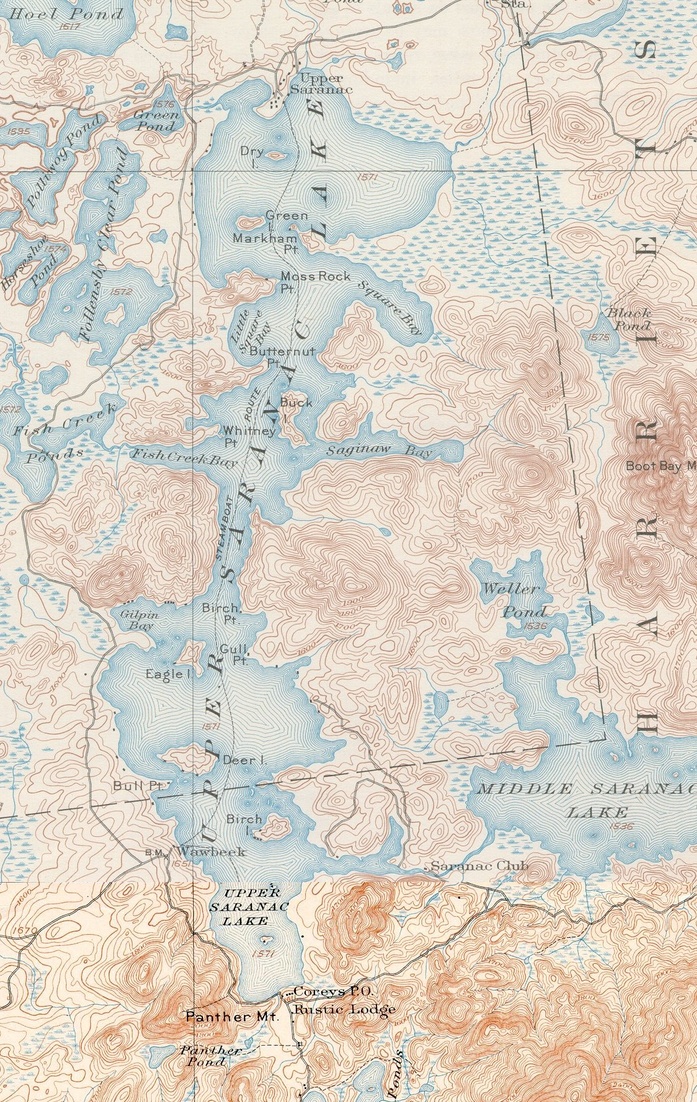 1905 St. Regis (top) and 1904 Long Lake quadrant USGS mapBays, Points, etc.
1905 St. Regis (top) and 1904 Long Lake quadrant USGS mapBays, Points, etc.
- Big Square Bay
- Birch Island
- Buck Island
- Bull Point
- Bungalow Bay
- Butternut Point
- Chapel Island
- Corey Island
- Deer Island
- Doctor's Island
- Douglass Point
- Dry Island
- Fish Creek Bay
- Gilpin Bay
- Goose Island
- Green Island
- Indian Point
- Josephine Island
- Little Square Bay
- Markham Point
- Moss Rock Point
- The Narrows
- Norway Island
- Panther Point
- Pelky Bay
- Saginaw Bay
- Spruce Island
- Tommy's Rock
- Waggaman Camp
- Lower Saranac Lake
- Middle Saranac Lake
- Deer Park
- Saranac Inn
- Saranac Club
Sources
- Jamieson, Paul and Morris, Donald, Adirondack Canoe Waters, North Flow, Lake George, NY: Adirondack Mountain Club, 1987. ISBN 0-935272-43-7.
- Tolles, Bryant F., Jr., Resort Hotels of the Adirondacks, Lebanon NH: University Press of New England, 2003. ISBN 1-58465-096-6.
External links
- New York State DEC - Camping Information
- ''New York Times'', "SUNSHINE AND PICNICS; A Combination Saranac Sojourners are Playing to the Limit", August 5, 1906
- ''New York Times'', "DEVOTEES OF TENT LIFE.; Enjoying the Fresh Air in the Adirondack Mountains", August 12, 1906
 View from the Wawbeek, 1912. The steam launch in the foreground was used to shuttle guests to the hotel from the railway near Saranac Inn.
View from the Wawbeek, 1912. The steam launch in the foreground was used to shuttle guests to the hotel from the railway near Saranac Inn. 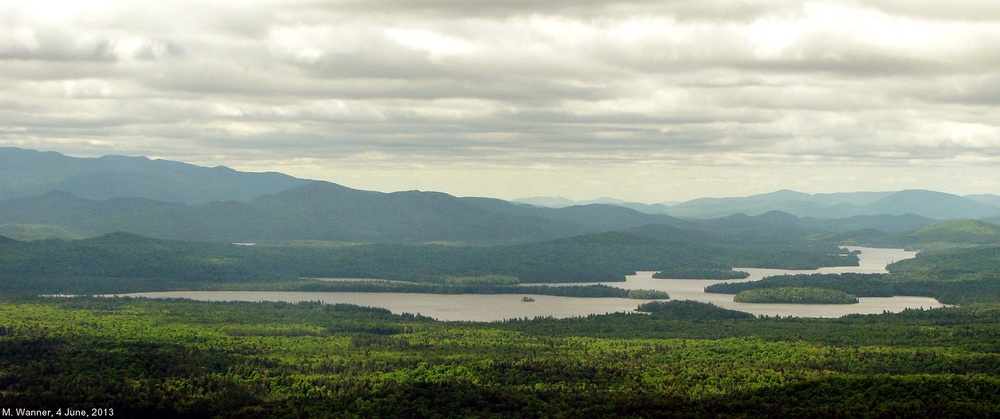 Upper Saranac Lake, looking south from St. Regis Mountain. Saranac Inn would have been about the center of the near shore. Visible are Goose and Green Islands, Markham Point, Moss Rock Point, Buck Island and the Narrows.
Upper Saranac Lake, looking south from St. Regis Mountain. Saranac Inn would have been about the center of the near shore. Visible are Goose and Green Islands, Markham Point, Moss Rock Point, Buck Island and the Narrows.
Footnotes
1. Jamieson, Paul and Morris, Donald, Adirondack Canoe Waters, North Flow, Lake George, NY: Adirondack Mountain Club, 1987.
2. GORP - Camping Upper Saranac Lake
3. ''Press Republican'', "Changes planned at Wawbeek property", February 22, 2008
4. This section appeared originally on "Wikipedia" as Upper Saranac Lake; its edit history there reflects its authorship prior to its appearance here. It is licensed under the License GDFL.